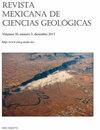Rincón de Parangueo干涸的马尔湖下的移动泥层及其微生物指纹的见解
IF 0.5
4区 地球科学
Q4 GEOSCIENCES, MULTIDISCIPLINARY
Revista Mexicana De Ciencias Geologicas
Pub Date : 2021-11-24
DOI:10.22201/cgeo.20072902e.2021.3.1636
引用次数: 1
摘要
我们在墨西哥Rincón de Parangueo (RP)的一个maar湖干涸的底部调查了饱和流动泥浆的次表层及其微生物指纹。采用了多尺度方法,包括地质野外调查、沉积物取心、探地雷达测量、物理化学表征(包括x射线衍射和扫描电镜)以及高通量DNA测序方法。流动泥浆为富有机质粉质粘土,具有较高的碱度、体积含水量和导电性。泥浆的流动性归因于与主动沉降相关的沉积物不平衡压实引起的超压,以及由地下水和沉积物中气体含量的输入产生的孔隙超压,并导致了与泥浆构造相关的各种结构,如注入圆顶和流体通过裂缝渗漏。对泥层中细菌和古细菌的沉积环境DNA进行了提取和测序。尽管获得的样本数量较少,但从地下沉积环境DNA中获得的微生物指纹与在陨石坑表面鉴定的微生物群落具有相似性。此外,我们还鉴定了泥浆中特定产甲烷微生物的DNA,如Bathyarchaeia、Methanomassiliicoccales和Methanobacteriales,并推测了它们在泥浆层产气和孔隙超压中的可能作用。Rincón de Parangueo的地下泥浆代表了一个地质动态环境,其条件有利于微生物群落的繁荣。本文章由计算机程序翻译,如有差异,请以英文原文为准。
Mobile mud layer underneath the desiccated maar lake of Rincón de Parangueo and insights into its microbial fingerprints
We surveyed a subsurface layer of saturated mobile mud and its microbial fingerprints below the desiccated bottom of a maar lake at Rincón de Parangueo (RP), Mexico. A multi-scale approach was followed using geological fieldwork, coring of the sediments, ground penetrating radar survey, physico-chemical characterization including X-ray diffraction and scanning electron microscope, and high-throughput DNA sequencing methods. The mobile mud is an organic-rich silty clay, with high values of alkalinity, volumetric water content and conductivity. Mud mobility has been attributed to overpressure caused by disequilibrium compaction of sediments related to active subsidence and pore overpressure produced by an input of groundwater and gas content in the sediments and resulted in a diverse set of structures related to mud tectonics such as injection domes and fluid seeps through fractures. Extraction and sequencing of sedimentary environmental DNA in the mud layer were performed for Bacteria and Archaea. Despite the small number of samples obtained, the microbial fingerprint from the sedimentary environmental DNA at subsurface shares similarities with the microbial communities identified on the crater surface. Additionally, we identify the DNA of specific methanogenic microorganisms in the mud, such as Bathyarchaeia, Methanomassiliicoccales, and Methanobacteriales, and we speculate on their probable role in gas production and pore overpressure in the mud layer. The underground mud at Rincón de Parangueo represents a geologically dynamic environment with conditions that are favorable for the thriving of microbial communities.
求助全文
通过发布文献求助,成功后即可免费获取论文全文。
去求助
来源期刊

Revista Mexicana De Ciencias Geologicas
地学-地球科学综合
CiteScore
1.00
自引率
12.50%
发文量
0
审稿时长
6-12 weeks
期刊介绍:
Revista Mexicana de Ciencias Geológicas (RMCG) publishes original research papers on geological processes of broad interest, and particularly those dealing with regions of Latin America. The RMCG also publishes review papers on topics of current interest, and on the geology and tectonics of geological provinces of Latin America. Besides, it offers the opportunity for host editors to publish special thematic issues.
 求助内容:
求助内容: 应助结果提醒方式:
应助结果提醒方式:


